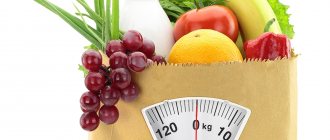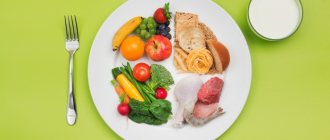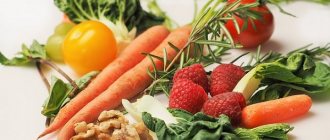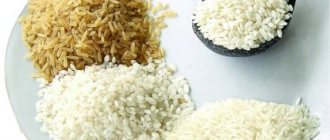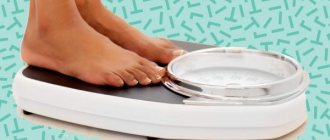Low-carbohydrate diet: menu for weight loss
A no-carbohydrate diet, as the name implies, is an eating regimen in which the amount of carbohydrates consumed is radically limited. Many different types of nutrition are based on limiting carbohydrates, with the preparation of corresponding menus: from Montignac and Dukan to the keto diet . All of the above is called a low-carbohydrate diet for weight loss.
At the same time, the number of calories consumed remains the same as always. This allows you not to reduce the amount of energy spent per day.
A diet without carbohydrates is intended only and exclusively for weight loss . Unlike therapeutic diets, completely healthy people use carbohydrate-free diets. This is necessary so that the diet does not cause an exacerbation of existing diseases.
How many carbohydrates can you eat on a no-carb diet?
Naturally, a complete ban on the consumption of carbohydrates with such a diet would be extremely harmful to health, and therefore a carbohydrate-free diet does not imply a drop in the amount of carbohydrates in the diet to zero and does not force a person to choose only strictly carbohydrate-free foods. It is necessary to realize the harm caused to the body by completely abstaining from carbohydrates. First of all, these are disturbances in the functioning of the intestines, because fiber also consists of carbohydrate substances and in second place (in order, but not in importance) is the lack of vitamins in the body that cannot be replaced by substances from fats and proteins. Carbohydrates are also essential for proper brain function.
Therefore, consuming carbohydrates even on low-carb diets is essential. The acceptable amount will be considered 50 grams per day; in special cases, this limit can be increased to 80 grams per day.
50-80 grams of carbohydrates will not harm the process of losing weight; the body will use most of the carbohydrates for the most necessary needs: brain function, intestinal function. But you should know that the carbohydrates consumed should have the lowest glycemic index possible, so choose your carbohydrate source more carefully.
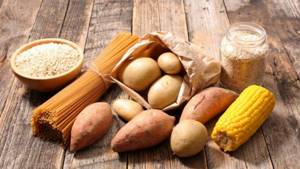
How many carbohydrates should I eat?
What do you eat with on carbohydrate-free diets?
KOLESNIKOVA TatyanaNutritionist
They have serious contraindications, and there are many of them. People who lose weight on these diets are most often obese, as this is an extreme version of the weight loss program. Here we are not talking about two or three kilograms, which are a little worrying, but about ten or more, that is, there is serious motivation. And obese people, as a rule, have a huge number of concomitant pathologies, for example, kidney pathology
(improper metabolism leads to the development of urolithiasis).
Excessive protein consumption with such diets is inevitable, since carbohydrates are excluded, and the amount of protein consumed exceeds the daily norm by up to two times. But protein is a fairly aggressive food, and the components into which it breaks down in the body are excreted mainly by the kidneys. Accordingly, the load on the kidneys increases sharply - hence urolithiasis, chronic renal failure, chronic pyelonephritis
. At some point, the protein may even show up in the urine, since the body cannot process it completely due to too much volume. In addition, protein without carbohydrates is not fully absorbed.
The second aspect: obese people usually have lipid spectrum disorders, that is, their cholesterol and “bad” fat levels are significantly higher than normal. If a person eats only animal proteins rich in cholesterol (dairy products, meat, eggs) for a long time, he accumulates it in the body. Accordingly, cholesterol levels on such a diet will inevitably begin to increase, and this can lead to the development of atherosclerosis
– disruption of the removal of bad fats from the body and their accumulation on the walls of blood vessels. In an obese person, this function is already impaired, and he also aggravates the problem with diet.
The third contraindication is gastrointestinal
.
Obese people often have such a disease (and sometimes they don’t even know about its existence) as cholelithiasis
.
Again, a diet consisting exclusively of proteins puts a lot of stress on the gallbladder and can provoke its development. The exclusion of carbohydrate foods also affects the functioning of the intestines themselves, since the lack of fiber is fraught with constipation. If there was a tendency to constipation initially, then during the period of protein diets this disease will worsen - there may be no stool for a week, and this becomes the norm. People are not accustomed to drinking a lot of liquid (and it helps the intestines work), and unprocessed food moves very slowly in the intestines. It can also worsen hemorrhoids
, which are often found in women of middle age, menopausal age, and those who have given birth - for them this becomes a background diagnosis.
cancer alertness
has become very developed recently , protein, as an aggressive product, is not recommended in large quantities for those who have suffered a similar disease. Their amount of protein in the diet should be reduced by almost 40% of the daily requirement, and this becomes a lifelong rule, especially with intestinal oncology. This diet is also contraindicated for diabetes mellitus, because - against the background of eliminating carbohydrates - the blood sugar level begins to fall.
Low-carbohydrate diet: menu for every day
Following a diet, especially such a complex one, is quite problematic. The best solution would be to create several one-day diets, from which you can create a menu for the week and month. This will make it easier to stick to a no-carb diet.
approximately daily menu on this type of diet will look like this:
- Morning meal: 2 boiled eggs (sources of protein), cheese (also a few slices), tea, no sugar
- Lunch : chicken breast, also cheese (you can have one slice instead of two or three), as well as vegetables to replenish fiber reserves and support intestinal motility
- Afternoon snack: nuts and half a grapefruit as a source of vitamins
- Dinner : as for lunch - chicken breast, but you can replace it with fish, you can also boil peas
- Drink kefir before bed
As we can see, during the day there are two sources of carbohydrates (namely fiber ) that can support the intestines and its work.
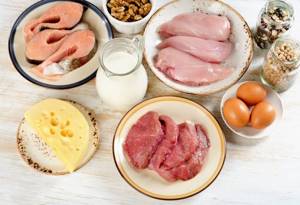
Menu for a low-carb week
In addition, you need to understand that while maintaining this diet you need to drink : at least one and a half liters during the day. But if you have just eaten, you need to wait half an hour before you can wash down your food with liquid.
Allowed list of foods on a low-carbohydrate diet
Before you start creating a menu, even for just one day, you need to figure out what you can eat while on a diet without carbohydrates. This is a rather limited list, because in our life more than half of the usual foods consist of carbohydrates almost entirely, and some of them contain so-called “ fast ” carbohydrates, which it is advisable to exclude from the menu even outside of any diet.
The food basket , the contents of which are used in the menu in a low-carbohydrate diet, consists mainly of protein products . In some cases, this list also includes fatty foods. This means that there are no restrictions on meat, fish or other animal products during this diet.
So, the list of products that can be used is as follows:
- First of all, it's meat . There are no restrictions on meat; it can be beef, rabbit, turkey or chicken. It is undesirable to eat pork , since the fat content of this meat has an excessively negative effect on health. A sharp increase in the amount of this meat in the diet can provoke the appearance of many diseases .
- by-products and eggs. Offal is liver, tongue or heart.
- Fish (in this case, you can use any type of fish as desired, since fish oil contains unsaturated fatty acids, which are very healthy), as well as seafood (squid, shrimp, crabs).
- Dairy products. In this case, just like with fish, almost any dairy products are allowed. Sweet yoghurts, whey drinks or other dairy products containing sugar should be excluded from the diet during this type of diet.
- Nuts or seeds. These foods also contain a huge amount of plant-based protein, making nuts or seeds a great option for a quick snack in case of unexpected hunger.
There is also a separate list of sources of “healthy” carbohydrates (fiber, vitamins, etc.):
- vegetables . In the form of vegetables, it is allowed to consume cabbage, peas or beans (preferably fresh, but boiled ones are also allowed), greens;
- fruits . You need to ensure that fruits have a low glycemic index. These are berries, citrus fruits and other similar fruits.
We see that the list of possible products for this type of diet is quite extensive and from them you can create a fairly varied menu for every day.
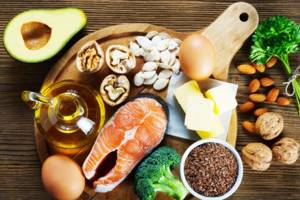
Allowed list of foods on a diet
By alternating foods with each other, you can eat well for several months and not feel any discomfort with this diet.
Basic rules (essence) of a low-carbohydrate diet
The menu on a low-carb diet looks like a small amount of meat with a side dish of vegetables and a dessert of fruit. This list of dishes is used during lunch hours and during dinner; these are the most satisfying dishes.
Breakfast and snacks between meals could consist of, say, a small amount of cheese or a couple of eggs. This allows a person not to feel hunger and the desire to “break” the diet.
At a certain point, the body begins to receive the missing energy by breaking down fat reserves. Fat is broken down extremely slowly, and therefore in order to start consuming it, you need to give the body a signal that it’s time to spend reserves.
The basis of nutrition will consist entirely of meat and dairy products, but they can be supplemented with oils (but only those consisting of unsaturated omega-3 fatty acids, which have a positive, not negative effect on the body), and also dilute protein and fatty foods with healthy fiber (in the form , say, broccoli or green beans).
If there are not enough vitamins in the diet, then their amount can be replenished with special vitamin complexes .
Also in this case, some people allow the use of sports protein. This product can actually serve as a source of good nutrients, namely muscle-healthy protein.
Also, sports nutrition can be really tasty and can be added to many common products, giving them an unexpected taste and making the menu even more valuable , varied and rich.
However, despite all the advantages, you need to realize that this nutrition is most useful for people who are in the process of building muscle. Also, sports nutrition requires careful selection, analysis of the composition and regularity of intake. In addition, you should not experiment with taking sports supplements on your own; you should visit a professional nutritionist or your doctor.
It is forbidden to eat any flour products, pasta, baked goods, or polished rice.
Any sweets , as well as juices (high sugar content), are completely excluded.

The main idea of a no-carbohydrate diet
The consumption of the following products is limited: brown rice, some cereals (for example, buckwheat), corn, as well as vegetables containing some sugar (tomatoes and zucchini), any soda , including mineral water. Nuts are also limited in consumption, since the vegetable protein contained in nuts is only partially digested.
Allowed:
- Any meat, except pork, fish and poultry.
- Eggs and offal.
- Green vegetables .
- Dairy products, including regular or skim milk or cottage cheese.
In total , as a result of drawing up the menu, there should be at least 2400 kcal .
But 2400 kcal per day is required to maintain constant shape. In order for the weight loss process to begin, the calorie intake needs to be reduced slightly; the ideal reduction would be 2000 kcal per day. These calculations will be valid for an average man with a height of 180 cm and a weight of 80-85 kg . In any other situation (for example, increased physical and mental stress, high metabolic rate), the diet needs to be adjusted for a specific person so that it is most suitable and the diet does not cause harm.
Products for a low-carbohydrate diet
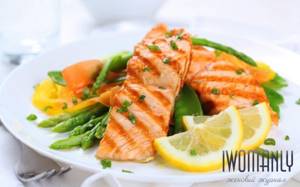
The main rule for losing weight and feeling good is the correct selection of products. The diet should be as balanced as possible with a small amount of carbohydrates in it. Prefer vegetable fats to animals; proteins can be consumed in almost any quantity, but do not forget about fruits and vegetables rich in fiber.
No carb foods list
From meat you can have such dishes, which contain no more than 20 grams of carbohydrates per 100 grams of product: beef, chicken, lamb, pork, duck, boiled sausage. For dairy products, give preference to low-fat cottage cheese, milk, cottage cheese, low-fat kefir and yogurt, and butter.
You can also eat a couple of pieces of hard cheese. Don't get carried away with mushrooms, peas and beans. They contain approximately 20 grams of carbohydrates per 100. Rye flour (7-8 g) contains 2 times less of the element prohibited in the diet than wheat flour (11-13 g).
The lowest carbohydrate cereal is rice (7 g), followed by semolina (10 g) and rice (12.5 g). The following vegetables can be eaten in any quantity: carrots (1.3 g), beets (1.5 g), cabbage (1.8 g), cucumber (1.8 g), pumpkin (4.2 g .), boiled onion (2.7 g), sweet pepper (2.2 g), cauliflower (0.4 g), tomatoes (2.8 g). Fruits you can use are pears and apples (0.5 g)
Low-carbohydrate diet for women
For women, the diet needs to be reworked. To lose weight, girls need to create an individual menu for each day, since a low-carbohydrate diet can aggravate some chronic diseases. Therefore, if a woman searches the Internet for recipes for a low-carbohydrate diet and independently creates a weight loss program for herself, then she will have to recalculate all the indicators for her own body.
Separately, you should think about the situation of pregnancy or breastfeeding.
Pregnant women should not adhere to this way of eating, since the lack of carbohydrates can deplete the body much faster and also harm the baby , which is formed precisely from the resources of the mother’s body.
During lactation , when the baby eats almost exclusively protein foods (milk), the woman also needs a sufficient amount of carbohydrates to replenish energy losses and have the strength to recover after childbirth and care for the child.
Before going on such a diet, a woman should examine her health for chronic diseases. You will also need to clarify the regularity of your hormonal cycles , since a sharp reduction in carbohydrates can in itself lead to hormonal imbalance and drive the body into stress, which will also not have a positive effect on health.

Women's low-carbohydrate diet
In general, a low-carbohydrate diet for a woman follows all the general rules for creating menus for such diets:
- Light breakfast of eggs or cheese
- Meat lunch with some vegetables and tea
- Afternoon snack with a light snack of nuts or cheese
- Dinner also includes meat and vegetables
The weekly menu will only change the types of meat, dairy products and drinks. For example , on Monday you can drink tea without sugar and eat some chicken breast, and on Tuesday replace the tea with still mineral water and the meat with a small piece of beef. Thus, a complete menu for the week is compiled.
Who is a low-carbohydrate diet contraindicated for?
Severely restricting carbohydrates forces the body to process fats. When fat is broken down, ketones are produced, harmful substances that disrupt the acid-base balance. Ketoacidosis develops, a disorder of carbohydrate metabolism, which without intervention can lead to coma. Other side effects of rapid weight loss: constipation, kidney problems, atherosclerosis, cardiovascular diseases, decreased immunity.
Menu is not suitable:
- for diabetes mellitus - the diet is based on protein foods;
- for digestive disorders, renal failure;
- during pregnancy and lactation.
Low-carbohydrate diet for men
In the case of a man, everything becomes much simpler. The male body breaks down fats body, so a diet without carbohydrates for a man, if he decides to stick to a diet, is much easier to create.
Here is an approximate menu for the week :
- eggs for breakfast , a lunch meal will consist of poultry and a small amount of vegetables, an afternoon snack with nuts and dinner with the same poultry and lettuce. All this is washed down with either water, which you need to drink in large quantities, or unsweetened tea.
- Breakfast on the second day of the diet looks the same as breakfast on the first; lunch includes meat, you can use beef and also vegetables . An afternoon snack looks like a snack with a piece of cheese, and dinner looks like a lunch meal, the same meat and side dish.
- The environment allows you to replace eggs for breakfast with something else, for example, a slice of cheese . Lunch, in general, follows the same pattern, so for lunch a person again eats a piece of meat and vegetables. You can make your afternoon snack a little more filling by eating a few boiled eggs. Dinner also includes meat and side dishes.
- The fourth day can be made a little easier, however, the menu for this day is built according to the same rules by which the rest of the menu is built.
- On Friday we return to our normal diet of eggs, meat and some vegetables.
- Saturday is also a fairly light day that requires you to consume a little less calories.
- Sunday allows you to gradually begin to return to the regular menu, if a person does not plan to stay on a low-carbohydrate diet for longer than a week.
of kefir at any time , which also helps maintain healthy intestinal microflora; this can be done at any time, including at night. And, of course, if you wish, you can replace meat with fish , such as tuna, which is rich in amino acids and omega 3 fatty acids.

Diet for men
Low-carbohydrate diet for athletes
An athlete only has to go on a low-carbohydrate diet during the “drying” period. What to eat during this time is determined by a personal nutritionist who develops a training program for a specific athlete.
“Cutting” involves burning fat reserves while maintaining maximum muscle mass . This is quite problematic to do, since muscles “lose” much faster than fat.
And of course, remember, during “drying”, it is impossible to gain muscle, because in order for the mass to grow, it is necessary to create a calorie surplus in the body, and during “drying”, on the contrary, there deficit , not to mention the fact that These are, in principle, two opposite processes from a biochemical point of view.
During drying, the body falls into a stressful situation, catabolic anabolic enter the blood , which are responsible for the growth of muscle mass.
In order to be able to burn fat, protecting muscles from destruction, that is, to keep them in good shape, you need to adhere to a special diet (mainly increasing the consumption of protein foods, and also including protein and BCAA amino acids in your diet) in combination with strength training and cardio training .

Diet for athletes
Training during “drying” is necessary, since if they are absent, then “drying” will be a regular carbohydrate-free diet that does not preserve muscles.
No-carbohydrate diet: pros and cons
The benefits of a low-carbohydrate diet are mainly in the area of sustainable results. You will actually lose those pounds that you needed to lose. In addition, the diet is quite inexpensive and varied.
The disadvantages of a carbohydrate-free diet are already more serious: the load on the excretory system, liver and kidneys . This load increases due to the fact that the percentage of protein and fatty foods in the diet increases significantly. Also, as a result of this diet, metabolism is disrupted, and the amount of vitamins and minerals is reduced.
A feature of a low-carbohydrate diet is also side effects such as weakness, nausea and intestinal problems.
Eating watermelon on a diet
Sometimes questions arise whether it is possible to eat watermelon on a carbohydrate-free diet, because it contains not only sugar, but also a large amount of liquid . However, it should be understood that the missing liquid can be replenished with water, but it is better to exclude sugar.
Therefore, watermelon in such a diet is, in principle, allowed due to the high content of micro and macroelements, as well as the presence of a large amount of vitamins (, B1, B2, B5, B6, B9)
However, it would be much better temporarily stop eating this healthy product.
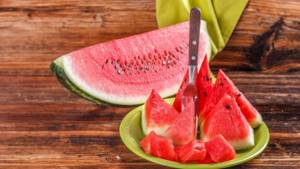
Is it possible to eat watermelon on a diet?
Prohibited foods for diet

If 100 grams of a product contains more than 20 g of carbohydrates, such products should be excluded from the diet on a carbohydrate-free diet.
These products include all dried fruits (45-65 g/100 g): raisins, dried apricots, prunes, dates. It is necessary to exclude sugar (99 g/100 g). It is strictly necessary to exclude sweets, sweet pastries, cookies, waffles, marshmallows, honey. You should also not eat sweet fruits: grapes, peach, banana, nectarine.
What not to eat on a no-carb diet
flour are prohibited on this diet . These include baked goods, pasta, and bread (both black and white).
One of the most sugar-containing products are carbonated drinks, which should also be avoided (not only do they contain empty calories , but also harmful preservatives, such as E211)
Candy should also be avoided due to its sugar content.
Separately go all vegetables containing a large amount of starch: carrots, beets and, most importantly, potatoes. Therefore, remember that vegetables are, of course, necessary for this type of diet, but, nevertheless, you should clarify which vegetables you eat.
Thus, in your no-carb diet, you should first eliminate the following foods:
- Carrot
- Corn
- Bananas
- Grape
- White rice
- Pasta
- Candies
- Flour products
- Sweet carbonated drinks
- Alcohol
All these products contain so-called “fast” carbohydrates, which are quickly broken down, supplying the body with glucose . This helps the body replenish missing energy and delays the start of fat breakdown in the body.

Unhealthy food
Therefore, remember that each meal of this type delays the beginning of losing extra pounds .
In general, we have a special table of glycemic indexes (GI), in which you can choose the most suitable product for your diet. GI foods in your diet .
Low-carb diet for weight loss: concept
Complete exclusion of carbohydrates from the diet deprives the body of an energy source. Quite quickly, such a diet will lead to severe fatigue, mood swings, sleepiness, headaches, and difficulty concentrating. So you should still leave a small amount of carbohydrates. The recommended daily intake on a strict low-carbohydrate diet for weight loss is 20-30g. It is important to use products that have a low glycemic index.
What it is? The glycemic index (GI) refers to the rate at which carbohydrates are absorbed and blood sugar rises. It is measured from 0 to 100. That is, with zero GI there are no carbohydrates at all, and 100 means their maximum amount. Those foods with a high GI provide the body with extra calories. And they, in turn, quickly turn into fat deposits - the body simply stores energy that is not needed at the moment in reserve. However, such products themselves do not lead to excess weight; this is caused by their excessive absorption in the absence of physical activity. In turn, those foods whose GI is low supply the body with more healthy carbohydrates - they are not absorbed so quickly, which means they do not provide energy immediately, but gradually. They should be consumed during a low-carbohydrate diet for weight loss.
GI is considered high in the range from 95 to 70 units.
The following products have it:
- sugar;
- baked goods, sweet pastries;
- white bread;
- milk chocolate;
- pancakes;
- mashed potatoes;
- boiled, baked potatoes;
- watermelon, melon, pumpkin;
- chips;
- sweet soda;
- dumplings;
- honey;
- instant porridges and cereals;
- rice noodles.
GI in the range from 65 units to 55 is considered average, it has:
- black bread;
- whole wheat bread;
- ice cream;
- mayonnaise;
- jam;
- Wheat flour;
- marmalade;
- raisin;
- ready-made industrial juices;
- canned vegetables;
- long grain rice;
- brown buckwheat;
- spaghetti;
- bananas;
- shortbread cookies;
- grapes and juice from it.
The following have a low (from 50 to 5) glycemic index:
- green buckwheat;
- oranges;
- mango;
- kiwi;
- brown rice and basmati;
- unsweetened juices: carrot, apple, cranberry, tomato, freshly squeezed orange;
- coconut;
- grapefruit;
- cabbage of all varieties;
- vegetables: carrots, cucumbers, eggplants, tomatoes, peas;
- oatmeal with water;
- spinach;
- soy;
- tofu;
- dried apricots;
- prunes;
- nuts;
- low-fat dairy products: yogurt, cottage cheese, kefir, milk;
- dark chocolate (70% cocoa).
Moreover, despite the low GI, some of these products contain a lot of calories. When adhering to a diet, it is worth remembering this and do not forget to check the calorie tables when creating your diet. You can also find data on the amount of carbohydrates in a particular product.
Low-carbohydrate diet: menu for 10 days
A ten-day period is a “quick effect” diet; as a rule, with more or less gentle loads, the result of the diet is hardly noticeable.
In order to see how many kilograms you have lost, the diet will have to be stricter than what nutritionists advise. This can seriously overload the kidneys and liver, especially if you abruptly eliminate carbohydrate consumption altogether and do not “get out” of this type of diet correctly.
As a rule, the menu for 10 days includes only meat, milk and eggs. During this time, the body does not have time to seriously lose its vitamin and mineral supply, and for such a period it is allowed to seriously limit itself in carbohydrates.
However, it should still be understood that all “strict diets” are a colossal blow to health, and therefore if you have a choice between a “regular” diet and a “strict” one, then the best choice would be to choose the regular option with a less reduced menu , but more extended in time.
But even a diet that lasts 10 days does not require cutting down the menu as much as a week-long no-carb diet.
Low-carbohydrate diet: 7 days for weight loss
The 7-day menu in a low-carbohydrate diet is even more rigid than even the 10-day menu. This happens because a person wants to lose approximately the same amount of excess fat in a week that he would lose on a regular menu for a month .
Of course, this type of diet cannot be beneficial, and therefore trying to lose significant weight in a week is highly not recommended.
The menu in this case is reduced to the maximum , limited to:
- Eggs
- Poultry meat
- Fish
- Unsweetened tea
Remember that you also need to drink a lot of water at this time. During very strict diets, you need to carefully monitor your health indicators and if you suspect that the body does not tolerate such stress well, you need to go to the doctor for a program to exit the diet. Yes, you need to get out of this kind of strict diet correctly, otherwise the load on the body at the moment of “returning to natural nutrition” will increase so much that it can lead to the hospital . Therefore, the best option for any person would be to give up “quick” diets and visit a nutritionist, or write to us and we will help you create a menu.
Remember that a diet cannot be fast, highly effective and safe for health at the same time.
Exit from a no-carb diet
Despite the fact that the carbohydrate-free nutrition system is not as strict as, for example, any mono-diet, leaving it must be done with great care. If you celebrate your victory with your favorite cake, then all your efforts can be nullified. Therefore, it is very important to strictly follow the following rules for exiting a low-carbohydrate diet:

- “return” prohibited foods into your life gradually, starting with 10 grams of net carbohydrates (unsweetened buckwheat porridge and brown rice, as well as unsweetened fruits, durum wheat pasta, wholemeal bread are suitable for this);
- try to eat fractionally, in small portions (5-6 times a day);
- do not skip a planned meal;
- give up sugar in drinks (tea, coffee);
- drink more water (daily intake: about 2 liters);
- start playing sports.

